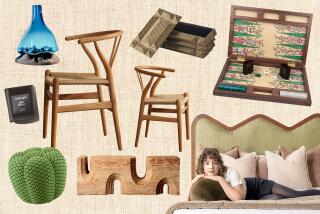Photos: Get ready to fall in love with Ikea’s new Sinnerlig collection from Ilse Crawford
- Share via
It’s taken more than three years, but Ilse Crawford’s homeware collection for Ikea has finally hit stores in the U.S. The London-based interior designer — whose far-reaching projects include Stockholm’s Ett Hem boutique hotel and Soho House New York — visited cork forests and bamboo plantations, among other places, to source materials used in the 30-piece Sinnerlig collaboration. “From a sustainability point of view, these materials have a lot of possibilities,” explains the designer, known for creating spaces that are warm and usable rather than grand and showy. The decidedly low-key pieces include stoneware pitchers and tableware, sea grass baskets, hand-blown glass bottles, a variety of lighting, and some covet-worthy tables and stools made with cork. Crawford, who was also a founding editor of influential Elle Decoration magazine, recently shared some insights into her designs.
Considering how complicated giant global companies can be, why did you want to collaborate with Ikea?
To be able to reach a wider audience, to do affordable, sustainable, desirable pieces without compromising standards is what most designers desire to do. The bonus was that working with a company like Ikea meant that we had access to extraordinary expertise. As the designs developed, we worked closely with experts for each step in the production process — from materials, sustainable textiles, manufacturing and environmentally-friendly coatings right through to logistics and transport. I think we both learned a lot from the collaboration!
Was there an overall concept that you and your Studioilse team kept in mind during the design process?
We’re interested by how to create environments with humanistic values — places that make us feel alive, that allow us to thrive. [So] it was important for us to use natural, tactile materials that respond to our primal human instincts. We wanted to create pieces that wouldn’t just look, but feel good to touch and use. We believe this is even more needed today, when we spend so much time touching technology.
We hit a few roadblocks, but we always came back to this idea upgrading natural materials. For the cork table in particular, we fought hard to retain the natural tactility of the raw material. As it’s a surface that will come into contact with food, the cork had to be sealed, [but] the usual methods of coating meant that the raw natural feeling of the material was lost. We developed a natural wax treatment, making a hygienic spill-proof finish without losing the beautiful raw imperfections of the cork.
Speaking of cork, there’s an abundance of it in the collection — what’s the appeal?
There’s a certain integrity and warmth to cork, which means it fits in so many environments, not to mention its versatility and practicality: it’s durable, it’s a thermal insulator, an acoustic softener, it’s waterproof and easy to clean. But, importantly, it feels good to touch. It felt right to use cork for the tables, stools and benches in particular because these are surfaces that we touch all of the time. And it’s a lot more forgiving on the bottom than wood.
Are the furniture pieces made to serve multiple purposes?
We observed that people today don’t need furniture with fixed functions, but rather furniture with a degree of flexibility that can be repurposed as people’s lives change. The collection fits loosely into the categories of working, dining and lounging, but they have been carefully developed as not to be prescriptive. It was more important to us that the pieces could be adapted to support however you wish to live with them. Following the launch of the collection in Europe we have seen people posting photographs of the collection in their homes and it’s really rewarding to see the collection being lived with in different ways.
The pieces are richly textured but also austere in some ways, which means they could easily fade into the background of a home. I’m wondering if that’s OK with you?
Of course! That’s surely the point of a piece from Ikea. It should upgrade daily life, yet just fit into anyone’s home, into their life, without standing out. We describe the collection ourselves as “helpful background pieces.” We have noticed with interiors there is still often the idea that making a home is only about buying a lot of stuff that looks nice. And then it’s never used. It was our intention to create everyday, useful pieces that can be lived with and loved, however you wish to live with them.
Due to global supply issues, some products in the new collection are limited or unavailable at the moment, so it’s best to contact your local Ikea to check what’s in stock.
ALSO:
17 ways to mix and match Ikea at home
Is this the ultimate Ikea hack? Greycork unveils flat-pack, tool-free furniture
Shoppe by Amber Interiors offers easygoing style in Old Town Calabasas






